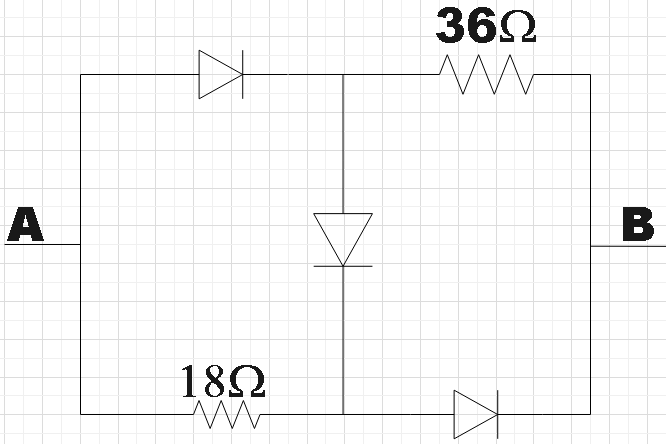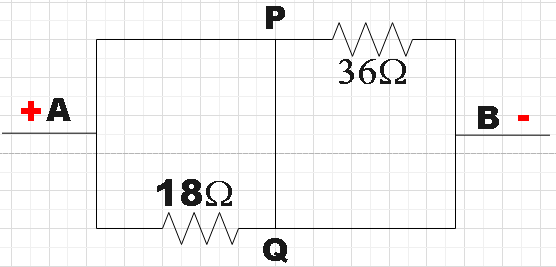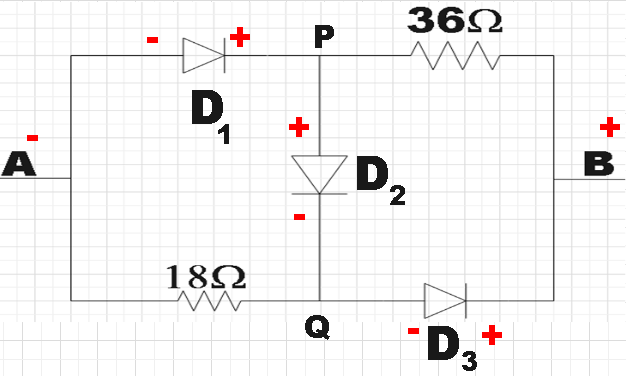
The equivalent resistance between A and B is

A. $36\Omega $ if ${{V}_{A}}\rangle {{V}_{B}}$
B. $18\Omega $ if ${{V}_{A}}\rangle {{V}_{B}}$
C. 0 if ${{V}_{A}}\rangle {{V}_{B}}$
D. $54\Omega $ if ${{V}_{A}}\rangle {{V}_{B}}$

Answer
521.4k+ views
Hint: We know that when diodes are present in a circuit, biasing has a key role. So we have two cases: one where A is positive and B negative and the second where A is negative and B is positive. The options are given for the first case, so we could bias accordingly and hence find the equivalent resistance.
Formula used:
Equivalent resistance in series,
${{R}_{eq}}={{R}_{1}}+{{R}_{2}}$
Complete answer:
In the question, we are given a circuit consisting of three diodes and two resistances and we are supposed to find the equivalent resistance across the terminals A and B.
Since the circuit consists of diodes we have two conditions: ${{V}_{A}}\rangle {{V}_{B}}$ and ${{V}_{A}}\langle {{V}_{B}}$
For ${{V}_{A}}\rangle {{V}_{B}}$,

We see that when${{V}_{A}}\rangle {{V}_{B}}$ , all the three diodes are forward biased and will act as a short circuit. So, under this condition the circuit could be redrawn as,

Since the resistors provide opposition to the current flow, the current would take the easiest path without any resistance if available, that is, APQB. So, the equivalent resistance when ${{V}_{A}}\rangle {{V}_{B}}$ would be zero.
Hence, option C is the correct answer.
Additional information:
When ${{V}_{A}}\langle {{V}_{B}}$
Now the biasing would be,

Here, we see that diodes ${{D}_{1}}$ and ${{D}_{3}}$ are reverse biased and would act like open circuits and hence there wouldn’t be any current flow in those arms. But the diode ${{D}_{2}}$ is forward biased and will act as a short circuit. Circuit could now be redrawn as,

Now across the terminals A and B we have two resistors connected in series and the equivalent resistance will now be,
$R=18\Omega +36\Omega =54\Omega $
Note:
Basically, we should be careful about the biasing when diodes are given in the circuit as they may act as short and open circuits accordingly. If you make a simple mistake even in assigning the signs you would end up getting the whole thing wrong. Also, always remember that the current will always take the easiest path.
Formula used:
Equivalent resistance in series,
${{R}_{eq}}={{R}_{1}}+{{R}_{2}}$
Complete answer:
In the question, we are given a circuit consisting of three diodes and two resistances and we are supposed to find the equivalent resistance across the terminals A and B.
Since the circuit consists of diodes we have two conditions: ${{V}_{A}}\rangle {{V}_{B}}$ and ${{V}_{A}}\langle {{V}_{B}}$
For ${{V}_{A}}\rangle {{V}_{B}}$,

We see that when${{V}_{A}}\rangle {{V}_{B}}$ , all the three diodes are forward biased and will act as a short circuit. So, under this condition the circuit could be redrawn as,

Since the resistors provide opposition to the current flow, the current would take the easiest path without any resistance if available, that is, APQB. So, the equivalent resistance when ${{V}_{A}}\rangle {{V}_{B}}$ would be zero.
Hence, option C is the correct answer.
Additional information:
When ${{V}_{A}}\langle {{V}_{B}}$
Now the biasing would be,

Here, we see that diodes ${{D}_{1}}$ and ${{D}_{3}}$ are reverse biased and would act like open circuits and hence there wouldn’t be any current flow in those arms. But the diode ${{D}_{2}}$ is forward biased and will act as a short circuit. Circuit could now be redrawn as,

Now across the terminals A and B we have two resistors connected in series and the equivalent resistance will now be,
$R=18\Omega +36\Omega =54\Omega $
Note:
Basically, we should be careful about the biasing when diodes are given in the circuit as they may act as short and open circuits accordingly. If you make a simple mistake even in assigning the signs you would end up getting the whole thing wrong. Also, always remember that the current will always take the easiest path.
Recently Updated Pages
Why are manures considered better than fertilizers class 11 biology CBSE

Find the coordinates of the midpoint of the line segment class 11 maths CBSE

Distinguish between static friction limiting friction class 11 physics CBSE

The Chairman of the constituent Assembly was A Jawaharlal class 11 social science CBSE

The first National Commission on Labour NCL submitted class 11 social science CBSE

Number of all subshell of n + l 7 is A 4 B 5 C 6 D class 11 chemistry CBSE

Trending doubts
What is meant by exothermic and endothermic reactions class 11 chemistry CBSE

10 examples of friction in our daily life

One Metric ton is equal to kg A 10000 B 1000 C 100 class 11 physics CBSE

1 Quintal is equal to a 110 kg b 10 kg c 100kg d 1000 class 11 physics CBSE

Difference Between Prokaryotic Cells and Eukaryotic Cells

What are Quantum numbers Explain the quantum number class 11 chemistry CBSE




